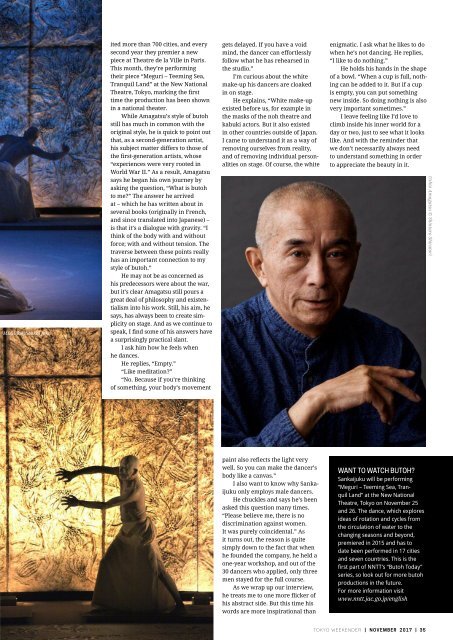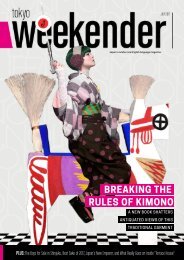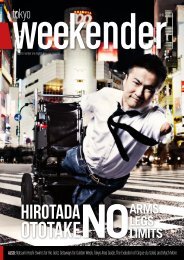Tokyo Weekender - November 2017
Our November issue is out, featuring a jam-packed end-of-year special: 42 Christmas gift shopping ideas and 10 bonenkai spots. Plus: The avant-garde world of butoh dance, Japanese teen prodigies, and a special supplement guide to Akita. Here's where to find a copy around Tokyo: www.tokyoweekender.com/pickup/
Our November issue is out, featuring a jam-packed end-of-year special: 42 Christmas gift shopping ideas and 10 bonenkai spots. Plus: The avant-garde world of butoh dance, Japanese teen prodigies, and a special supplement guide to Akita. Here's where to find a copy around Tokyo: www.tokyoweekender.com/pickup/
You also want an ePaper? Increase the reach of your titles
YUMPU automatically turns print PDFs into web optimized ePapers that Google loves.
MEGURI@Sankai Juku<br />
ited more than 700 cities, and every<br />
second year they premier a new<br />
piece at Theatre de la Ville in Paris.<br />
This month, they’re performing<br />
their piece “Meguri – Teeming Sea,<br />
Tranquil Land” at the New National<br />
Theatre, <strong>Tokyo</strong>, marking the first<br />
time the production has been shown<br />
in a national theater.<br />
While Amagatsu’s style of butoh<br />
still has much in common with the<br />
original style, he is quick to point out<br />
that, as a second-generation artist,<br />
his subject matter differs to those of<br />
the first-generation artists, whose<br />
“experiences were very rooted in<br />
World War II.” As a result, Amagatsu<br />
says he began his own journey by<br />
asking the question, “What is butoh<br />
to me?” The answer he arrived<br />
at – which he has written about in<br />
several books (originally in French,<br />
and since translated into Japanese) –<br />
is that it’s a dialogue with gravity. “I<br />
think of the body with and without<br />
force; with and without tension. The<br />
traverse between these points really<br />
has an important connection to my<br />
style of butoh.”<br />
He may not be as concerned as<br />
his predecessors were about the war,<br />
but it’s clear Amagatsu still pours a<br />
great deal of philosophy and existentialism<br />
into his work. Still, his aim, he<br />
says, has always been to create simplicity<br />
on stage. And as we continue to<br />
speak, I find some of his answers have<br />
a surprisingly practical slant.<br />
I ask him how he feels when<br />
he dances.<br />
He replies, “Empty.”<br />
“Like meditation?”<br />
“No. Because if you’re thinking<br />
of something, your body’s movement<br />
gets delayed. If you have a void<br />
mind, the dancer can effortlessly<br />
follow what he has rehearsed in<br />
the studio.”<br />
I’m curious about the white<br />
make-up his dancers are cloaked<br />
in on stage.<br />
He explains, “White make-up<br />
existed before us, for example in<br />
the masks of the noh theatre and<br />
kabuki actors. But it also existed<br />
in other countries outside of Japan.<br />
I came to understand it as a way of<br />
removing ourselves from reality,<br />
and of removing individual personalities<br />
on stage. Of course, the white<br />
enigmatic. I ask what he likes to do<br />
when he’s not dancing. He replies,<br />
“I like to do nothing.”<br />
He holds his hands in the shape<br />
of a bowl. “When a cup is full, nothing<br />
can be added to it. But if a cup<br />
is empty, you can put something<br />
new inside. So doing nothing is also<br />
very important sometimes.”<br />
I leave feeling like I’d love to<br />
climb inside his inner world for a<br />
day or two, just to see what it looks<br />
like. And with the reminder that<br />
we don’t necessarily always need<br />
to understand something in order<br />
to appreciate the beauty in it.<br />
Ushio Amagatsu © Shintaro Shiratori<br />
paint also reflects the light very<br />
well. So you can make the dancer’s<br />
body like a canvas.”<br />
I also want to know why Sankaijuku<br />
only employs male dancers.<br />
He chuckles and says he’s been<br />
asked this question many times.<br />
“Please believe me, there is no<br />
discrimination against women.<br />
It was purely coincidental.” As<br />
it turns out, the reason is quite<br />
simply down to the fact that when<br />
he founded the company, he held a<br />
one-year workshop, and out of the<br />
30 dancers who applied, only three<br />
men stayed for the full course.<br />
As we wrap up our interview,<br />
he treats me to one more flicker of<br />
his abstract side. But this time his<br />
words are more inspirational than<br />
WANT TO WATCH BUTOH?<br />
Sankaijuku will be performing<br />
“Meguri – Teeming Sea, Tranquil<br />
Land” at the New National<br />
Theatre, <strong>Tokyo</strong> on <strong>November</strong> 25<br />
and 26. The dance, which explores<br />
ideas of rotation and cycles from<br />
the circulation of water to the<br />
changing seasons and beyond,<br />
premiered in 2015 and has to<br />
date been performed in 17 cities<br />
and seven countries. This is the<br />
first part of NNTT’s “Butoh Today”<br />
series, so look out for more butoh<br />
productions in the future.<br />
For more information visit<br />
www.nntt.jac.go.jp/english<br />
TOKYO WEEKENDER | NOVEMBER <strong>2017</strong> | 35
















